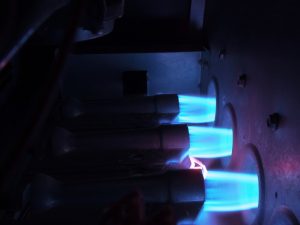 Are you one of the many homeowners in our area who uses a gas-powered furnace to keep your household comfortable? If so, we understand why! These powerful systems are durable and help you achieve optimal comfort. But, there is one potential safety risk to be aware of, and that’s a cracked heat exchanger. Of all the furnace repair needs you might ever need, this is the #1 need not to ignore or delay.
Are you one of the many homeowners in our area who uses a gas-powered furnace to keep your household comfortable? If so, we understand why! These powerful systems are durable and help you achieve optimal comfort. But, there is one potential safety risk to be aware of, and that’s a cracked heat exchanger. Of all the furnace repair needs you might ever need, this is the #1 need not to ignore or delay.
Just like any other powerful piece of equipment or appliance that produces combustion gas, an ill-maintained furnace can create health and safety hazards. No, furnaces aren’t inherently dangerous, but they can become so if you skip maintenance or delay a necessary repair like this one.
Cracked heat exchangers aren’t something that typically afflicts newer heating systems, but rather those around 10-15 years old. Read on to learn more!
The Heat Exchanger’s Job
This component of your furnace is essential to the functionality of your natural gas-powered heating system. It’s the area where the heat from the combustion gasses gets transferred to the indoor air form the blower fan. From there, the air moves to the ventilation system.
Combustion gasses should never come in contact with your indoor air. If they do, unhealthy fumes will enter your living space. Combustion gas enters the heat exchanger (this is a metal, clam-shaped chamber or a series of chambers). The heat from the combustion gas raises the temperature of the metal, and as the air from the blower passes it, heat transfers to the exchanger.
In other words, your furnace system’s heat exchanger is what actually makes it possible for your furnace to heat the home.
What Happens with a Damaged Heat Exchanger
When a heat exchanger is damaged, exhaust fumes are able to get into the component, and then leak into the indoor air. The most toxic of these fumes is CO, or carbon monoxide gas. This can create severe health problems for household occupants, and even fatalities.
A well-maintained and cared for furnace will send CO fumes out through a flue. However, a crack will allow some CO to leak out.
But what causes this? The most likely reason this happens is because of corrosion—the reaction between the metal of your heater and the combustion gas over time causes the metal to weaken. This is why it’s something mainly to watch for in older, aging furnaces. Even the smallest crack in a heat exchanger can be a problem, too, since it opens wider when the temperature gets hotter.
Do You Have a Cracked Heat Exchanger?
If you have had your furnace maintained this year, it’s likely that you don’t have a problem with your heat exchanger, since this is something professional HVAC technicians check for. If you skipped maintenance, however, then it is important for you to know what signs to watch out for that could indicate a cracked heat exchanger.
For instance, if you detect a clicking noise coming from your furnace after the blower shuts off, you may, in fact, have a cracked heat exchanger. If you suspect anything is amiss with your heater, the best thing you can do is call in the pros!
Need expert furnace service in Puyallup, WA? Contact Sound Heating and Air Conditioning Inc. today! We take your comfort as serious as you do.
